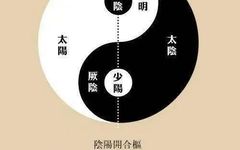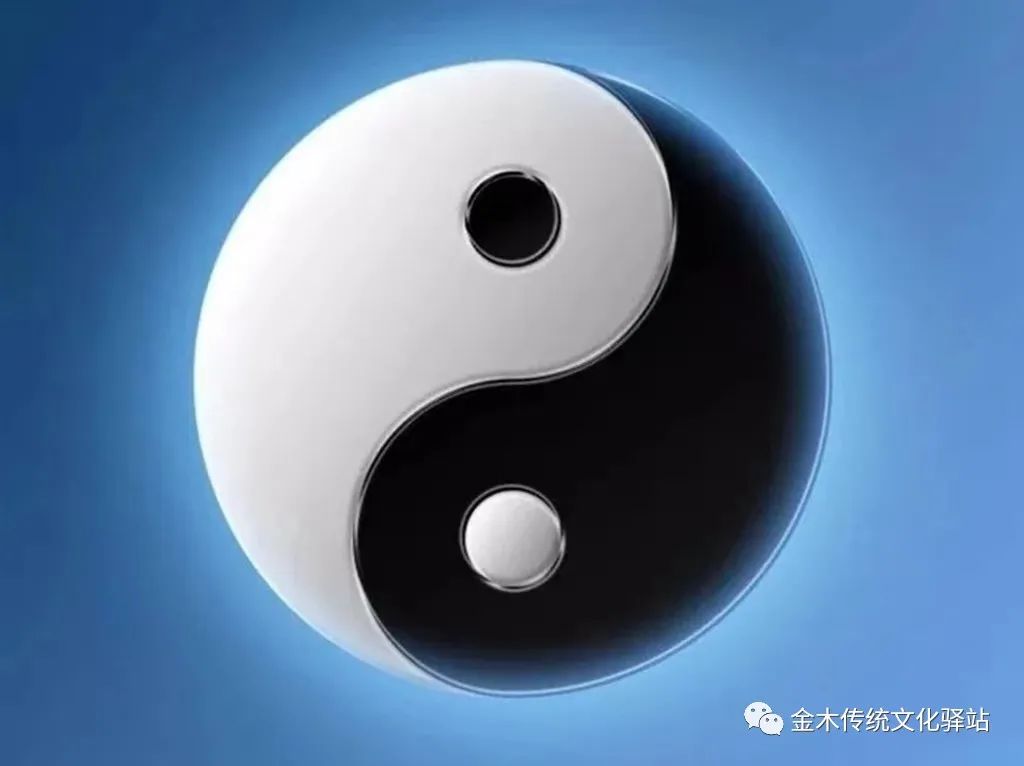
1. The Opposition of Yin and Yang
Intense movement, outwardness, rising, warmth, brightness, male, light, and dispersion all belong to Yang; conversely, relative stillness, inwardness, descending, coldness, darkness, female, heavy, and convergence all belong to Yin. In terms of heaven and earth, the light and clear weather is Yang, while the heavy and turbid earth energy is Yin; regarding water and fire, water is cold and moist, thus belongs to Yin, while fire is hot and ascending, thus belongs to Yang.
In terms of up and down, left and right, south and north; heaven and earth, movement and stillness, rising and descending, etc., the upper part belongs to Yang, while the lower part belongs to Yin; left is Yang, right is Yin; south is Yang, north is Yin; heaven is Yang, earth is Yin; movement is Yang, stillness is Yin, rising is Yang, and descending is Yin. Additionally, Qi—promoting the metabolism of substances, is characterized by warmth, promotion, excitement, and rising, thus belongs to Yang. Jing—substantial basis for functional activities, is characterized by coolness, tranquility, inhibition, and sinking, thus belongs to Yin.
The internal relationship of Yin and Yang in the human body: from the perspective of body parts, the upper part is Yang, the lower part is Yin; the body surface is Yang, the interior is Yin; the back is Yang, the abdomen is Yin; the outer sides of the limbs are Yang, while the inner sides are Yin. In terms of organs, the five Zang organs (Xin (Heart), Gan (Liver), Pi (Spleen), Fei (Lung), Shen (Kidney)) belong to Yin, as their functions are primarily static;
the six Fu organs (Dan (Gallbladder), Wei (Stomach), Xiao Chang (Small Intestine), Da Chang (Large Intestine), Pang Guo (Bladder), San Jiao (Triple Burner)) belong to Yang, as their functions are primarily dynamic. Among the five Zang organs, they can also be divided into Yang organs (Xin (Heart), Fei (Lung)) and Yin organs (Gan (Liver), Pi (Spleen), Shen (Kidney)), where the functions of each organ can be categorized as Yang, while their substances can be categorized as Yin.
In the meridians, there is also a division of Yin and Yang. The meridians belong to Yin, while the collaterals belong to Yang, and within the meridians, there are Yin meridians and Yang meridians, and within the collaterals, there are Yin collaterals and Yang collaterals. Regarding the twelve primary meridians, there are distinctions between the three Yang meridians of the hand and the three Yin meridians of the hand, as well as the three Yang meridians of the foot and the three Yin meridians of the foot. Between blood and Qi, blood is Yin, while Qi is Yang. Within Qi, Ying Qi (Nutrient Qi) is internal and belongs to Yin, while Wei Qi (Defensive Qi) is external and belongs to Yang, etc.
Anything that is excited, hot, moving, strong, bright, formless, and light is considered Yang, while anything that is declining, inhibited, cold, still, weak, dark, tangible, and heavy is considered Yin.
Moreover, within Yin and Yang, there is also Yin and Yang. That is, within Yin there is Yang, and within Yang there is Yin. In terms of day and night, day is Yang, while night is Yin.
In nature, the four seasons of spring, summer, autumn, and winter have changes in warm, hot, cool, and cold climates. Summer is originally characterized by abundant Yang heat, but after the summer solstice, Yin energy gradually increases to restrain the hot Yang energy; while winter is originally characterized by abundant Yin cold, but after the winter solstice, Yang energy gradually revives to restrain the severe cold of Yin.
Spring and summer are warm because the Yang energy rises in spring and summer to suppress the coldness of autumn and winter; autumn and winter are cold because the Yin energy rises in autumn and winter to suppress the warmth of spring and summer.
Yin and Yang achieve unity through their opposing struggle, maintaining a dynamic balance, which is referred to as “Yin Ping Yang Mi”; only then can the body carry out normal life activities.
2. The Interdependence of Yin and Yang
The opposing sides of Yin and Yang are mutually dependent; neither side can exist independently of the other. For example, up is Yang, down is Yin; without up, there is no down; heat is Yang, cold is Yin; without cold, there is no heat. Therefore, it can be said that Yang depends on Yin, and Yin depends on Yang; each side exists conditionally based on the existence of its relative counterpart.
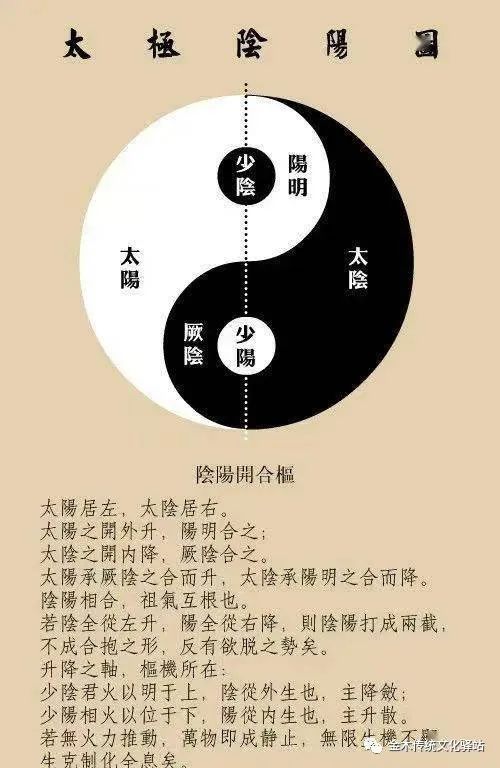
3. The Growth and Decline of Yin and Yang
During the day, Yang is abundant, and the physiological functions of the body are primarily excited; while at night, Yin is abundant, and the physiological functions of the body are correspondingly inhibited. From midnight to noon, Yang energy gradually increases, and the physiological functions of the body gradually shift from inhibition to excitement, which is Yin diminishing and Yang increasing; while from noon to midnight, Yang energy gradually declines, and the physiological functions of the body shift from excitement to inhibition, which is Yang diminishing and Yin increasing. The transition from spring to summer and from autumn to winter is the process of the growth and decline of Yin and Yang.
When Yang is abundant, it leads to heat:Yang abundance is a pathological change where Yang evil is excessive, manifesting as heat-related diseases. Yang evil can cause the body’s Yang energy to become excessive, resulting in high fever, sweating, dry mouth, red face, and rapid pulse, which are all manifestations of heat; hence, it is said that “Yang abundance leads to heat.”
Because Yang abundance often leads to the damage of Yin fluids, such as in cases of high fever, sweating, red face, and rapid pulse, there will inevitably be a phenomenon of Yin fluid depletion and thirst, thus it is said that “Yang abundance leads to Yin disease.” “Yang abundance leads to heat” refers to the nature of diseases caused by Yang evil; “Yang abundance leads to Yin disease” refers to the fact that Yang abundance inevitably damages the body’s righteous Qi (Yin fluids).
When Yin is abundant, it leads to cold:Yin abundance is a pathological change where Yin evil is excessive, manifesting as cold-related diseases. Yin evil can cause the body’s Yin energy to become excessive, resulting in abdominal pain, diarrhea, cold limbs, pale tongue with white coating, and deep pulse, which are all manifestations of cold; hence, it is said that “Yin abundance leads to cold.”
Yin abundance often leads to the damage of Yang energy, such as in cases of abdominal pain, diarrhea, pale tongue with white coating, and deep pulse, there will inevitably be a phenomenon of Yang energy depletion and cold limbs, thus it is said that “Yin abundance leads to Yang disease.” “Yin abundance leads to cold” refers to the nature of diseases caused by Yin evil; “Yin abundance leads to Yang disease” refers to the fact that Yin abundance inevitably damages the body’s righteous Qi (Yang energy).
The decline of Yin and Yang includes: Yin deficiency (Yin Xu) and Yang deficiency (Yang Xu)
1. Yang deficiency leads to external cold:Yang deficiency is the deficiency of Yang energy in the body. According to the principle of dynamic balance of Yin and Yang, any deficiency in either Yin or Yang will inevitably lead to the relative excess of the other. Yang deficiency cannot restrain Yin, thus Yin becomes relatively excessive, resulting in cold symptoms: for example, when the body’s Yang energy is weak, it may present as pale complexion, cold limbs, fatigue, spontaneous sweating, and weak pulse; its nature is also cold, hence it is called “Yang deficiency leads to cold,” which means Yang diminishes and Yin increases.
2. Yin deficiency leads to internal heat:Yin deficiency is the insufficiency of Yin fluids in the body. Yin deficiency cannot restrain Yang, thus Yang becomes relatively excessive, resulting in heat symptoms. For example, prolonged illness depleting Yin or inherent deficiency of Yin fluids may present as tidal fever, night sweats, five hearts heat, dry mouth and tongue, thin rapid pulse, and sallow complexion; its nature is also hot, hence it is called “Yin deficiency leads to heat,” which means Yin diminishes and Yang increases.
3. Mutual damage of Yin and Yang:Yin damage to Yang and Yang damage to Yin, both Yin and Yang are deficient, referred to as “Yin and Yang both deficient.” When Yang deficiency reaches a certain extent, due to Yang deficiency failing to generate Yin fluids, Yin deficiency will simultaneously appear, referred to as “Yang damage to Yin.” For example, patients with long-term reduced appetite often present with spleen Qi (Yang) deficiency, as the spleen and stomach are the foundation of postnatal essence and the source of Qi and blood generation; weak spleen Qi (Yang) leads to insufficient transformation, resulting in Yin (blood) deficiency.
Similarly, when Yin deficiency reaches a certain extent, due to Yin deficiency failing to generate Yang energy, Yang deficiency will simultaneously appear, referred to as “Yin damage to Yang.” For example, patients with blood loss, due to significant loss of blood (Yin), Qi follows the blood loss, often present with cold limbs and Yang deficiency symptoms: “Yang damage to Yin” or “Yin deficiency leading to Yang deficiency” ultimately leads to “Yin and Yang both deficient.”
To distinguish between Yang abundance leading to heat, Yin abundance leading to cold, and Yang deficiency leading to cold, Yin deficiency leading to heat, Yang abundance leading to heat is referred to as “excess heat,” while Yin deficiency leading to heat is referred to as “deficiency heat,” Yin abundance leading to cold is referred to as “excess cold,” and Yang deficiency leading to cold is referred to as “deficiency cold.” As for Yang damage to Yin, Yin damage to Yang leading to both Yin and Yang deficiency, they all fall under the categories of deficiency cold and deficiency heat; Yang damage to Yin is primarily deficiency cold, with deficiency heat secondary; Yin damage to Yang is primarily deficiency heat, with deficiency cold secondary.
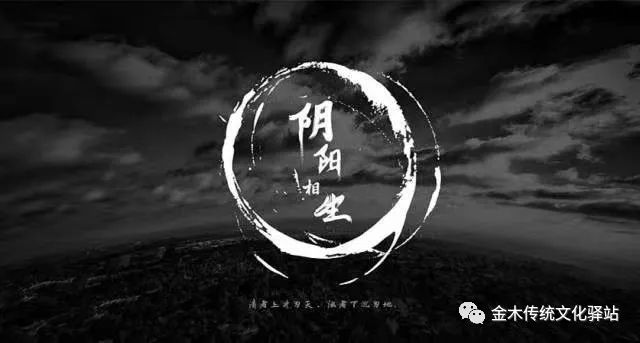
4. The Transformation of Yin and Yang
Certain acute warm diseases, characterized by high fever, red face, agitation, and strong rapid pulse, due to severe heat toxin, can greatly deplete the body’s original Qi. In the case of sustained high fever, there may suddenly be a drop in body temperature, cold limbs, and a weak pulse, which is a manifestation of the transformation from Yang syndrome to Yin syndrome.
For example, in patients with cough and asthma, when symptoms such as cough, shortness of breath, thin white phlegm, no thirst, pale tongue with white coating, and wiry pulse appear, the syndrome is cold (Yin syndrome). Often due to severe external pathogens, cold evil binds the Yang energy, transforming it into heat, resulting in symptoms such as coarse cough, yellow thick phlegm, thirst, red tongue with yellow coating, and rapid pulse, which then belong to heat (Yang syndrome). The transformation of Yin and Yang must meet certain conditions, which in TCM are referred to as “heavy” or “extreme.” Hence, it is said: “Heavy Yin must lead to Yang, heavy Yang must lead to Yin,” “extreme cold generates heat, extreme heat generates cold.”
5. Applications
(1) Many diseases are due to Yin and Yang imbalance
For example, observing the complexion: bright colors belong to Yang, while dark colors belong to Yin; listening to the voice: loud voice belongs to Yang, while soft voice belongs to Yin; preference for cold drinks indicates Yang, while preference for hot drinks indicates Yin; pulse that is floating, rapid, and strong belongs to Yang, while deep, slow, and thin belongs to Yin, etc. From the perspective of syndrome types, diseases located on the surface belong to Yang, excess syndromes belong to Yang, heat syndromes belong to Yang; while diseases located internally belong to Yin, deficiency syndromes belong to Yin, cold syndromes belong to Yin, etc.
(2) Determining treatment principles and clinical medication: For deficiency heat syndromes caused by Yin deficiency, nourishing Yin herbs should be used to replenish deficiency; for deficiency cold syndromes caused by Yang deficiency, warming Yang herbs should be used to replenish Yang. In cases of both Yin and Yang deficiency, both must be supplemented.
The treatment principles for Yin and Yang excess:Reduce the excess, and drain the excess. Yin and Yang excess refers to the overabundance of either Yin or Yang, which is an excess syndrome. Since Yang abundance leads to Yin disease, Yang abundance leads to heat, and excessive Yang heat easily damages Yin fluids, while Yin abundance leads to Yang disease, Yin abundance leads to cold, and excessive Yin cold easily damages Yang energy, thus when adjusting the excess of Yin and Yang, attention should be paid to whether there is a corresponding deficiency of Yin or Yang. If there is an excess of Yin or Yang without corresponding deficiency, the principle of “reducing the excess” can be applied. If there is a corresponding deficiency, then both the deficiency and excess should be addressed, using methods to support Yang or nourish Yin.
Yang abundance leading to heat is an excess heat syndrome, and it is advisable to use cooling herbs to restrain Yang, treating heat with cold, i.e., “cool the heat.” Yin abundance leading to cold is an excess cold syndrome, and it is advisable to use warming herbs to restrain Yin, treating cold with heat, i.e., “warm the cold.” Since both are excess syndromes, this treatment principle is referred to as “reducing the excess,” i.e., “drain the excess,” which is to expel evil.
The treatment principles for Yin and Yang deficiency:Supplement the deficiency, and nourish the deficient. Yin and Yang deficiency refers to the insufficiency of either Yin or Yang, which can be Yin deficiency or Yang deficiency. Yin deficiency cannot restrain Yang, leading to Yang excess, which is a deficiency heat syndrome, and the treatment should nourish Yin to suppress Yang. Generally, cooling herbs should not be used to directly reduce heat; instead, it is necessary to strengthen water to control fire, nourishing Yin to restrain Yang, which is the treatment method that seeks to address the nature of the condition, i.e., using “strengthening the water to control the Yang fire” to nourish Yin and lower fire, thus suppressing Yang excess. For example, if there is insufficient kidney Yin, it leads to deficiency fire rising; this is not an excess of fire, but a deficiency of water, thus it is necessary to nourish kidney water.
The “Huangdi Neijing” refers to this treatment principle as “treating Yang disease with Yin.” If Yang deficiency cannot restrain Yin, leading to Yin excess, it is a deficiency cold syndrome, and the treatment should support Yang to restrain Yin. Generally, it is not advisable to use pungent warming dispersing herbs to disperse Yin cold; instead, it is necessary to enhance fire to eliminate Yin, which is also a treatment method that seeks to address the nature of the condition, i.e., using “enhancing the source of fire to eliminate Yin shadows” to support Yang and enhance fire, thus eliminating Yin excess. The “Huangdi Neijing” refers to this treatment principle as “treating Yin disease with Yang.”
The treatment principles for mutual damage of Yin and Yang:Supplement Yang with Yin, supplement Yin with Yang, and supplement both Yin and Yang: Regarding the treatment principles for Yang damage to Yin, Yin damage to Yang, and both Yin and Yang being deficient, based on the principle of mutual dependence of Yin and Yang, when Yang damage occurs, the treatment for Yang should consider Yin, i.e., on the basis of sufficiently supplementing Yang, Yin should also be supplemented (supplement Yang with Yin); when Yin damage occurs, the treatment for Yin should consider Yang, i.e., on the basis of sufficiently supplementing Yin, Yang should also be supplemented (supplement Yin with Yang); when both Yin and Yang are deficient, both should be supplemented to correct this low-level balance.
(3) Summary of the properties and flavors of Chinese herbs: The four Qi (also known as four natures) are cold, hot, warm, and cool. The five flavors are sour, bitter, sweet, pungent, and salty. The four Qi belong to Yang, while the five flavors belong to Yin.
Among the four Qi, cold and cool herbs belong to Yin, while warm and hot herbs belong to Yang; among the five flavors, pungent flavors can disperse and move, while sweet flavors can nourish Qi, thus pungent and sweet belong to Yang, such as Gui Zhi (Cinnamon Twig) and Gan Cao (Licorice); sour flavors can astringe, while bitter flavors can purge, thus sour and bitter belong to Yin, such as Da Huang (Rhubarb) and Shao Yao (Peony); bland flavors can promote diuresis (in terms of the concentration of substances, concentrated is Yin, diluted is Yang), thus bland belongs to Yang, such as Fu Ling (Poria) and Tong Cao (Rice Paper Plant); salty flavors can moisten and descend, thus belong to Yin, such as Mang Xiao (Mirabilite); those with astringent, sinking, and purging effects belong to Yin, while those with dispersing, rising, and ascending effects belong to Yang.
According to the ascending and descending floating and sinking characteristics of herbs, light herbs with ascending effects belong to Yang, such as Sang Ye (Mulberry Leaf) and Ju Hua (Chrysanthemum Flower); heavy herbs with sinking effects belong to Yin, such as Gui Ban (Tortoise Shell) and Zhe Shi (Hematite). Therefore, among the five flavors, sour, bitter, and salty belong to Yin, while pungent, sweet, and bland belong to Yang.
(4) Guiding health preservation and disease prevention
The changes of Yin and Yang in the human body are in harmony with the changes of Yin and Yang in nature throughout the four seasons, which can prolong life: thus, it is advocated to follow nature, nourishing Yang in spring and summer, and nourishing Yin in autumn and winter.
In spring and summer, Yang energy is released, and Qi and blood tend to the surface of the body, resulting in relaxed skin, open pores, and increased sweating; while in autumn and winter, Yang energy is stored, and Qi and blood tend to the interior, resulting in dense skin and reduced sweating with increased urination.
The human body adapts to the day and night cycle: daytime is Yang, while nighttime is Yin; the human body also experiences the initial emergence of Yang energy in the morning, the peak of Yang energy at noon, and by night, Yang energy retracts, allowing the body to rest and recover energy.
Therefore, treating diseases involves determining treatment principles based on the Yin and Yang excess or deficiency of the condition, and then selecting appropriate herbs based on the Yin and Yang properties and effects of the herbs to achieve a state of balance, harmony, and stability.
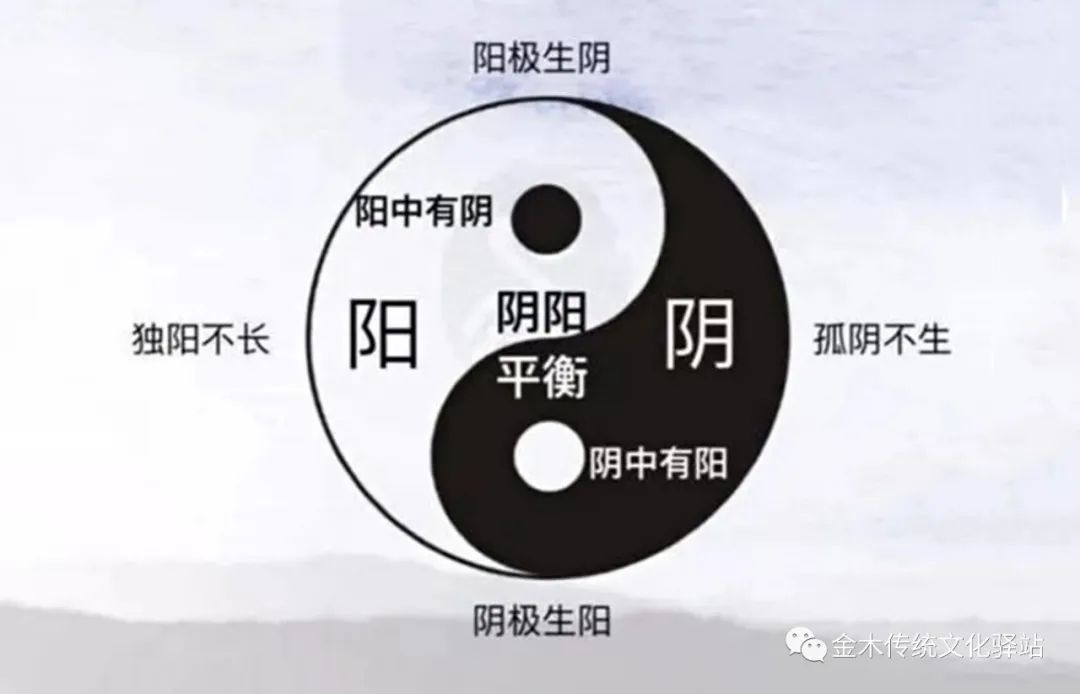
Thinness and Fatness in Relation to Yin and Yang
Example: Thin people are prone to Yin deficiency, while fat people are prone to Yang deficiency.
Generally speaking, thin individuals tend to be Yang, and being Yang inevitably leads to Yin deficiency, hence the saying: “Thin people often have heat.” Thin individuals are often prone to heat. Conversely, fat individuals tend to be Yin, and are often deficient in Yang. Those who are Yin abundant are also Yang deficient, presenting as cold intolerance, hence the saying: “Fat people often have dampness.” Fat individuals often have dampness because their spleen function is insufficient to transform excess water and food, leading to excess nutrition being converted into fat.
Disseminationof TCM health preservation knowledge, promoting Chinese traditional culture,sharing health concepts, conveying care, and passing on health knowledge and traditional culture to more friends…
People are great because they have dreams; we are different because we have love.
Liu Qing Ning: 186 9643 6785 or (WeChat ID)
Yang Shun Song: 138 7171 7447 or (WeChat ID)


